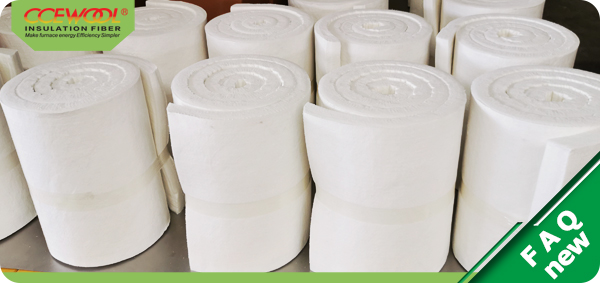Car bottom furnaces are widely used in the metallurgical industry for heat treatment and heating processes. Based on different process requirements, they can be categorized into heating furnaces (1250–1300°C) and heat treatment furnaces (650–1150°C). With the growing emphasis on energy efficiency and production needs, lightweight, low-heat-capacity high-temperature insulation fiber materials have been extensively adopted. Among them, the CCEWOOL® Refractory Ceramic Fiber Blanket plays a vital role in the lining structure of car bottom furnaces due to its excellent temperature resistance, thermal insulation performance, and installation flexibility.
Insulation Requirements for Car Bottom Furnaces
Car bottom furnaces operate in complex environments and typically feature a three-layer composite lining structure: hot face layer, insulation layer, and backing layer. Fiber materials used for the intermediate insulation and backing layers must meet the following performance criteria:
•High temperature resistance and thermal shock resistance: To handle frequent heating and cooling cycles.
•Low thermal conductivity and low heat capacity: To enhance thermal efficiency and reduce energy consumption.
•Lightweight and easy to install: To reduce structural load and improve installation efficiency.
•Good structural stability: To ensure long-term use without cracking or spalling.
Material Properties of CCEWOOL® Refractory Ceramic Fiber Blanket
•High temperature rating: Covers a range from 1050°C to 1430°C, meeting the needs of various furnace types.
•Low thermal conductivity: Maintains excellent thermal barrier performance even at high temperatures, significantly reducing the external surface temperature of the furnace shell.
•High tensile strength: Strong mechanical properties ensure resistance to tearing or deformation during installation and long-term use.
•Excellent thermal stability and thermal shock resistance: Maintains structural integrity even under frequent start-stop conditions.
•Flexible installation: Can be cut and layered based on furnace structure, suitable for complex areas such as furnace walls, roofs, and doors.
Application of Refractory Ceramic Fiber Blanket in Metallurgical Car Bottom Furnaces
(1) In Car Bottom Heating Furnaces
Heating furnaces operate at temperatures up to 1300°C, requiring high-performance refractory materials.
CCEWOOL® Refractory Ceramic Fiber Blanket is commonly used as an insulation or backing layer in these furnaces:
•Furnace walls and roof: Two layers of 30mm-thick CCEWOOL® ceramic fiber blanket are laid and compressed to 50mm thick to form an effective insulation layer under the high-temperature working surface.
•Used in conjunction with ceramic fiber modules: The refractory ceramic fiber blanket serves as a thermal buffer, protecting the modules and extending the service life of the overall furnace lining system.
•Furnace doors and base: The CCEWOOL® ceramic blanket is used as a backing layer to provide additional thermal protection.
(2) In Car Bottom Heat Treatment Furnaces
Heat treatment furnaces operate at lower temperatures (up to approximately 1150°C) and place greater emphasis on energy savings, thermal efficiency, and thermal stability.
CCEWOOL® Ceramic Fiber Blanket is widely used as the primary insulation material:
•Furnace walls and roof: Installed in 2–3 flat-laid layers and combined with module systems to form a lightweight composite lining.
•Multi-layer composite structure: The refractory ceramic fiber blanket serves as a backing or intermediate buffer layer when used with high-alumina modules, creating a highly efficient “flexible + rigid” insulation structure.
•Significant energy savings: The low heat capacity of the CCEWOOL® refractory ceramic fiber blanket minimizes heat loss during heating and holding, making it especially suitable for frequent start-stop operations.
Installation and Structural Advantages
CCEWOOL® Ceramic Fiber Blanket is installed using a layered, staggered-joint method to avoid thermal bridging and enhance overall insulation effectiveness. It is often used in conjunction with herringbone anchor structures and suspended fiber modules to ensure a secure and durable system.
Additionally, in cylindrical or specially structured furnaces, CCEWOOL® Refractory Ceramic Fiber Blanket can be arranged in a “tiled floor pattern” to flexibly adapt to complex geometries, significantly improving installation efficiency and structural sealing.
With its high-temperature performance, low thermal conductivity, ease of installation, and outstanding thermal shock resistance, CCEWOOL® Refractory Ceramic Fiber Blanket has become one of the preferred insulation materials for car bottom furnace linings in the metallurgical industry. Whether in high-temperature heating furnaces or heat treatment furnaces, it demonstrates comprehensive advantages in energy efficiency, reliability, and maintainability, embodying the high-performance trend of modern furnace lining systems.
As a professional supplier of ceramic fiber blankets and ceramic blankets, CCEWOOL® remains committed to providing the metallurgical industry with high-quality, sustainable refractory insulation solutions.
Post time: Apr-07-2025


